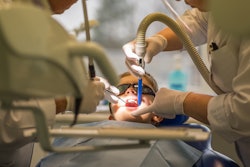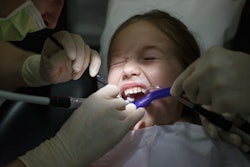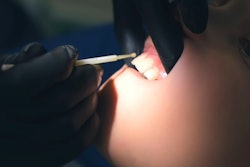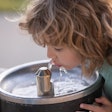
Silver diamine fluoride (SDF), SDF/potassium iodide (KI), and sodium hypochlorite (NaOCl) may prevent caries better than nanosilver fluoride (NSF) and chlorhexidine (CHX), according to a study recently published in the Journal of Dentistry.
Furthermore, SDF and SDF/KI exhibited superior antibacterial activity compared to NSF. However, combining SDF with KI may not significantly change the antibacterial efficacy of SDF alone, according to the study.
"SDF, SDF/KI, and NaOCl displayed significantly higher antibacterial activity against dual-species biofilm compared to NSF and CHX (p <0.050)," wrote the authors, led by Büşra Karaduran of the Istanbul University Department of Pediatric Dentistry in Turkey. (J Dent, May 27, 2024, 105097.)
In pediatric dentistry, the use of silver-containing materials is becoming increasingly popular. This study aims to help pediatric dentists determine which solution might be the most effective for preventing caries.
The antimicrobial activity of various solutions, including sterile saline, 5% sodium hypochlorite (NaOCl), 2% chlorhexidine (CHX), SDF, SDF/KI, NSF, and KI, was tested against Streptococcus mutans (S. mutans) and Lactobacillus casei (L. casei) using disc diffusion tests. A dual-species biofilm of S. mutans and L. casei was formed on 48 enamel samples, which were divided into six groups (n = 8), they wrote.
Group one was treated with sterile saline, group two with 5% NaOCl, group three with 2% CHX, group four with SDF, group five with SDF/KI, and group six with NSF. Then the samples were analyzed using confocal laser scanning microscopy and scanning electron microscopy. Statistical analysis was performed, according to the study.
A significant difference was observed in the median inhibition zones against S. mutans when treated with different solutions (p <0.001). SDF and SDF/KI solutions showed the largest inhibition zones against S. mutans. The 5% NaOCl and 2% CHX solutions produced significantly smaller inhibition zones compared to SDF and SDF/KI. However, sterile saline, NSF, and KI solutions showed no antibacterial activity.
For L. casei, a significant difference was found in the median inhibition zones with the various solutions (p <0.001). Multiple comparisons revealed that 2% CHX was the most effective solution against L. casei. The 5% NaOCl, SDF, and SDF/KI solutions also showed efficacy, with no significant difference among them. As with S. mutans, sterile saline, NSF, and KI solutions did not exhibit any antibacterial activity, the authors wrote.
However, the absence of coating materials in the study may have limited the stabilization of NSF, they wrote. In the future, research should thoroughly assess the antibacterial efficacy, stabilization, and cytotoxicity of NSF and compare it to SDF and SDF/KI for more comprehensive results, the authors added.
"Based on the findings of this study, it can be concluded that SDF and SDF combined with KI exhibit superior antibacterial activity compared to NSF," Karaduran et al concluded.




















